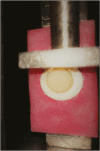Comparison of the Bond Strength of Composite Resin to Zirconia and Composite Resin to Polyether Ether Ketone: An In Vitro Study
- PMID: 33149512
- PMCID: PMC7595458
- DOI: 10.4103/jpbs.JPBS_147_20
Comparison of the Bond Strength of Composite Resin to Zirconia and Composite Resin to Polyether Ether Ketone: An In Vitro Study
Abstract
Aim: The aim of the study was to compare the shear bond strength of composite resin bonded to polyether ether ketone (PEEK) and zirconia, and also to evaluate the effect of thermocycling on the shear bond strength.
Materials and methods: A total of 22 zirconia (Group 1) and 22 PEEK (Group 2) specimens (disks of 10 mm in diameter and 10 mm in thickness) were machine milled using computer-aided design (CAD)/computer-aided manufacturing (CAM) from commercially available zirconia and PEEK. These specimens were air abraded with 110-μm aluminum oxide. Following which these two groups were subdivided into four groups, that is, Group 1A: 11 zirconia specimens before thermocycling, Group 1B: 11 zirconia specimens after thermocycling, Group 2A: 11 PEEK specimens before thermocycling, and Group 2B: 11 PEEK specimens after thermocycling. These four groups of specimens were embedded in an acrylic block, and bonding agent was applied over the upper surfaces of the disks of each of these specimens. Composite resin was then cured, and then Group 1B and group 2B were thermocycled under a standard temperature. The bond strength of the specimen was tested using universal testing machine.
Result: The result showed that there was no significant difference in shear bond strength between the groups, although higher shear bond strength was observed in the PEEK group.
Conclusion: Shear bond strength of PEEK is similar to zirconia. The results suggest that the pretreatment method and primers used were effective in improving the bonding of resin cements to zirconia ceramic and the bonding properties of the veneering resin to the PEEK surface.
Keywords: BioHPP; composite; polyether ether ketone; shear bond strength; thermocycling; zirconia.
Copyright: © 2020 Journal of Pharmacy and Bioallied Sciences.
Conflict of interest statement
There are no conflicts of interest.
Figures





References
-
- Santing HJ, Meijer HJ, Raghoebar GM, Özcan M. Fracture strength and failure mode of maxillary implant-supported provisional single crowns: a comparison of composite resin crowns fabricated directly over PEEK abutments and solid titanium abutments. Clin Implant Dent Relat Res. 2012;14:882–9. - PubMed
-
- Stawarczyk B, Keul C, Beuer F, Roos M, Schmidlin PR. Tensile bond strength of veneering resins to PEEK: impact of different adhesives. Dent Mater J. 2013;32:441–8. - PubMed
-
- El-Ghany OS, Sherief AH. Zirconia based ceramics, some clinical and biological aspects. Future Dent J. 2016;2:55–64.
-
- Von Steyern P, Carlson P, Nilner K. All-ceramic fixed partial dentures designed according to the DC-zirkon technique. A 2-year clinical study. J Oral Rehabil. 2005;32:180–7. - PubMed
-
- Tannous F, Steiner M, Shahin R, Kern M. Retentive forces and fatigue resistance of thermoplastic resin clasps. Dent Mater. 2012;28:273–8. - PubMed
LinkOut - more resources
Full Text Sources
Miscellaneous
